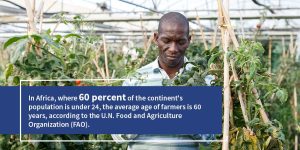Youth in agriculture: how to engage and retain youth in agricultural activities
by Justus Njeru
Aug 12, 2019
7 min
This blog focuses on how we can engage and retain youth in agricultural activities. Its also walks us through how MSC helps its clients to tailor its services through vocational training, technological innovation and skills & entrepreneurship development to create opportunities for youth.
When I was a young boy growing up in rural Kenya, farm work was punishment—be it at school, digging the farm if you had pending homework or at home, picking coffee and tea while it rained. With these experiences, nothing would have motivated me to choose a course that is related, in any way, to agriculture. That, however, changed along the way. That is not who I am today.
In many developing countries, agriculture and allied courses and professions have been “orphaned”. Usually, students who join public universities can choose such “archaic” agricultural courses that are available usually with lower qualifying grades. The media has not helped either. The negative imagery of emaciated farm families, reports of unpaid farmers, and devastating post-harvest management, such as rotting cereals and fruit dominate the media’s agricultural coverage. All these have negatively affected the youth’s perception of agriculture.
The African Union’s Malabo Declaration, which set agriculture goals for 2025, works to create job opportunities for at least 30% of youth in agricultural value chains across the continent. However, investments that support skills, knowledge, employment, and finance for young people are still lacking—especially in rural areas.
Data from the Population Reference Bureau in 2018 projects that the population of Sub-Saharan Africa will more than double by 2050. Africa’s youth population, currently at 20%, will rise to 35% of the total youth in the world by 2050. Studies have shown that agricultural growth in Sub-Saharan Africa has a greater positive impact on reducing poverty compared to growth in other sectors. Hence, tapping into the reservoir of employment opportunities in agriculture is indispensable for poverty reduction.
Why does agriculture not attract youth?
Agriculture in Sub-Saharan Africa is the main source of income and subsistence for over 70% of the adult population. The sector supports more than 40% of the total employed population in the region. Despite the potential of agriculture to create employment, the steadily increasing youth population in Africa has been turning away from it due to the hard work, poor remuneration, and other negative factors associated with it. Youth unemployment rates in South Africa are almost four times higher than the regional average—62% of South Africans between 15 and 35 years of age are unemployed. Of them, 60% have never been employed.
Sub-Saharan Africa has a huge potential with 60% of the world’s uncultivated arable land. Yet it spends USD 25 billion annually on food imports. A comparison of Africa with other continents highlights that the difference lies in its low adoption of technology. If this divide is crossed, Sub-Saharan Africa could produce enough food for its own population and even become a net exporter of food.
Youth inclusion, engagement, and most importantly, retention in the agriculture sector are hot topics. The international community has raised this concern and national governments have spoken on the issue repeatedly. The youth, on the other hand, consider agricultural jobs painstaking and unrewarding. These jobs also require a lot of patience that the millennials lack as pointed out by a Leeds University study: Millennial impatience and the rise of next day delivery. Several youth agri-initiatives have been developed to address this gap but many have failed to achieve the desired results. This begs the question—how can we attract, engage, and retain youth in the field of agriculture?
Can digitization bridge the divide between youth and agriculture?
The average age of an African farmer is between 45 and 60 years. Even though the farmers are attached to their traditions and quite reluctant to change, they are not immune to the technology revolution. Just like the banking industry where mobile money technologies have become pervasive despite the old banking system, agriculture must follow suit. Digital innovations and the use of Information and Communication Technologies (ICTs) will prove essential to unlocking Africa’s agri-business and bridge the rural divide. This will help smallholder and family farmers, fishers, pastoralists, and forest-dwellers.
According to the World Bank’s report “Growing Africa: Unlocking the Potential of Agribusiness”, Africa’s farmers and agribusinesses could create a trillion-dollar food market by 2030 if they can expand their access to more capital, increased access to electricity, better technology, and irrigated land, among other things. The agribusiness logistics sector is essential to agricultural transformation through value-chain development. ICT will be pivotal to provide efficient agribusiness logistics and to link producers and final consumers almost instantaneously. The emerging Agriculture Technology (AgTech) start-ups have demonstrated this—and in the process, attracted youth to provide best practices, agricultural networking, and linking to finance. However, the AgTechs will need to work closely with experienced organizations in the low and middle-income segment, especially smallholder households, to tailor solutions for the market as demonstrated by MSC.
According to a blog by CGAP on promoting digital financial products among the youth, behavior segmentation and data analytics are critical to understanding the variance between predicted users and actual users of digital products among youth. However, MSC’s blog on digital credit clients cautions that most youth will juggle between lenders. In Kenya for example, the Central Bank (CBK) estimates that over 500,000 people listed on credit reference bureau (CRB) for owing less than USD 2 are youth between 18 to 24 years. They were listed on the CRB after taking a small loan to use it for gambling, after which they lost the bet and failed to pay the amount back.
Financial access to youth
Financial Service Providers (FSPs) continue to shy away from financing youth, terming the group risky. Banks across Sub-Saharan Africa still provide “vanilla” products that are delivered through the brick-and-mortar approach. This is compounded by the banks’ limited understanding of the financing opportunities along agricultural value chains. The difference in aspirations of the FSPs and the youth has increased the exclusion of youth from the agriculture finance continuum.
Consultative Group to Assist the Poor (CGAP)’s financial diaries and national surveys with smallholder households indicate that young people in rural areas save two to five times as much as their elders. These savings were four to five times the amount they borrowed from different sources. The statistics highlight that youth can and should be involved in transforming agriculture.
Research in Behavioral Economics is essential to design and implement solutions to improve services and job opportunities for these segments. MSC’s proficiency in behavioral, gender-centric, and market-sensitive program design helps us develop products and channels that cater to the specific needs of women and youth. We have a long history of working on financial and skill development services for the youth. MSC has developed a wide range of savings and credit products tailored and targeted specifically for a range of youth segments—from schoolchildren to those in their twenties. We conduct market assessments on opportunities for youth employment. We also develop and deliver training programs that support employability and technical skills for both youth and women.
Case studies of youth engagement in agriculture
MSC helped Musoni Microfinance, Kenya to review its agriculture finance product and introduce digital credit assessment for clients. Musoni is a microfinance institution (MFI) that utilizes ICT to increase the efficiency of service delivery for rural clients. It has successfully targeted rural youth through products and services delivered through technology. Musoni’s agricultural finance product—Kilimo Booster—is a success in targeting youth engaged in agricultural production. A client who owns a dairy farm in rural Kenya attested this.
In Tanzania, the Alliance for Green Revolution in Africa (AGRA) provided a USD 540,000 grant to SELF Microfinance Fund (SELF) to develop digitally delivered products for smallholder farmers. MSC helped the Mahanje SACCO located in the Ruvuma region to review its loan products to suit the needs of targeted rural clients. Members of the SACCO can now access credit, repay, and save using their mobile phones. The convenience and privacy of transactions created by digitization attracted about 300 new clients, which represents a 14% growth rate in the 18-month project period alone. Out of these, 120 (40%) were aged between 18 and 25 years.
MSC provided technical support to the Land and Investment for Future Transformation (DAI-LIFT Ethiopia) project between 2016 and 2019. The project worked to accelerate access to finance smallholder farmers through seven MFIs. As of June 2019, 12,098 loans worth USD 12.5 million have been disbursed and USD 1.1 million in deposits mobilized. The project has reached vulnerable groups through the Gender, Equality, and Social Inclusion (GESI) pillar. About 30% of the loans are directed to the GESI group that includes youth. About 400 land rental service providers have also been employed, with almost 60% of them aged 18–25.
So, how do we attract and retain youth in agricultural activities?
Digital technology and digital financial services have the potential to bring youth closer to the agricultural sector. The players in the ecosystem focused on promoting agriculture needs to deliberately create an attractive and enabling environment for youth through:
- Sustainable market linkages between rural young farmers and urban markets through e-commerce or m-commerce platforms, such as the Agrocenta in Ghana, 2Kuze and SokoNect in Kenya
- Integrate various actors and activities across value chains and create meaningful employment for youth
- Adopt digital platforms that offer an opportunity for embedded social services that could compensate for the lack of financial and non-financial services and provide social protection, such as platforms that offer embedded unemployment insurance or health insurance; Specialization in service provision—information, data and, value chain linkages
- Special support to build value addition, capacity-building, and idea incubations
- Efficiency in agriculture value chains that will spur growth in the trade margins and returns and thus encourage youth to engage fully in the sector
- Work with FSPs to develop financial tools and products that facilitate access to finance for agriculture-related activities by youth
- Position the youth in risk management mechanisms among smallholder farmers and agri-businesses, along selected agriculture value chains
Leave comments
Edwin karuri
22 Aug, 2019
Hello Mr.Justus, This article motivates me. The youth always look for the white colar jobs leaving their ageing parents to do the farming. Rarely will the parents make it to deliver the much needed farm produce. Good work sir! Keep it up.
Jackson Bulili
16 Aug, 2019
Well done my co-expert, congrats
Jackson Bulili
16 Aug, 2019
Well done my co-expert, congrats
Victoria Antwi
16 Aug, 2019
Very insightful
Victoria Antwi
16 Aug, 2019
Very insightful
Daniel Ikaaba
14 Aug, 2019
In relation to youth inclusion in agriculture i would suggest 4 priority areas that are hindering youth inclusion to be addressed; they include access to finance, skills development, enabling environmnet enhancement and market linkages for inputs and outputs
Daniel Ikaaba
14 Aug, 2019
In relation to youth inclusion in agriculture i would suggest 4 priority areas that are hindering youth inclusion to be addressed; they include access to finance, skills development, enabling environmnet enhancement and market linkages for inputs and outputs
Written by

 by
by  Aug 12, 2019
Aug 12, 2019 7 min
7 min 

Comments (7)